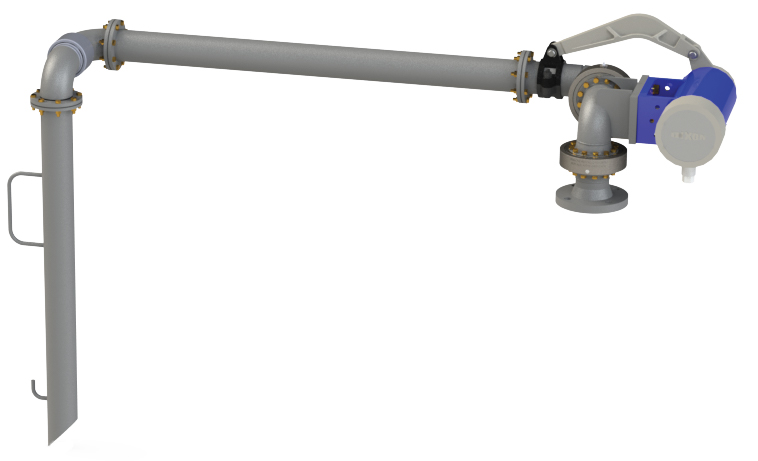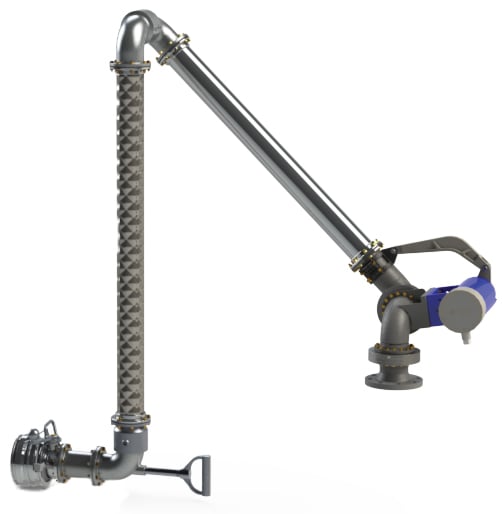
Loading arms improve safety and efficiency by allowing liquid cargo to be transferred into trucks, railcars, vessels, and barges using an articulated pipe system. Rigid pipe loading arms are generally constructed of several pipes - or legs - which are linked together with swivel joints and supported by a counterbalance. Loading arms can also be constructed of a combination of pipe and lengths of flexible hose to improve flexibility and range of motion. Dixon manufactures loading arms in 2”, 3”, and 4” sizes. Custom-engineered loading arms in other sizes and configurations are also available upon request.

Top loading arms are used to transfer liquids directly through a manhole hatch located on the tanker's roof, or through a flange bolted to the tanker’s dome. When used in conjunction with accessory components such as hatch cover plates, tapered hatch plugs, and inflatable hatch seals, top-loading arms can also be utilized for tight-fill, vapor recovery, and other transfer applications. Often, for some non-hazardous cargoes, the connection may be "open," implying that the manhole hatch is not sealed. A hatch cover on the tanker's manhole can provide a "semi-closed" connection to eliminate splashing. Hazardous cargos typically require a "closed" connection with vapor recovery.
In addition to transferring cargo, loading arms can also be used for transferring propulsion fuel into a vessel. This operation is commonly referred to as bunkering.
There are several attachments available to make a loading arm more ergonomic and effective, such as pneumatic positioners, quick couplers, safety breakaway couplers, and purge, and drain valves.

This type of arm is used to load or unload road and rail tankers from the bottom of the tank. Loading a cargo from the bottom-upward reduces splashing and minimizes the production of foam and fugitive vapors. The configuration of the legs is determined by the location of the connection on the tanker. A connection on the rear of a truck tanker for example, usually necessitates a greater arm length than a side connection. This type of loading arm can be connected through a flange, or through a coupler such as a cam& groove or dry disconnect.
Although they are less flexible than top-loading arms, they are the safest choice because the operator stays on the ground. The total loading time can be reduced due to faster connections and greater fill rates. A powerful swivel and counterbalance spring are common on bottom-loading arms, allowing for a greater arm reach and the ability to connect with multiple tanker models.
The bottom loading arm, like the top loading arm, may be customized with numerous accessory components to make the operator’s job safer and more efficient.
Benefits of loading arms:
More effective in fall prevention
Loading arms can often be incorporated with existing fall protection equipment for added protection and are considerably more practical to keep out of the way. Rigid pipe loading arms are less likely to fail than hoses that are routed over the ground. Hose failures due to abrasion are frequently the cause of spills and expensive environmental cleanups. Additionally, hoses on or near walking and working surfaces are a well-known cause of slips, trips, and falls.
Offer more safety devices:
- Safety breakaway couplings: Safety breakaway couplings are used to avoid pull-away incidents, to preserve terminal and loading/unloading equipment, and to prevent undesired product release. The breakaway couplings are designed to intentionally break apart at a specified place under a predetermined load. When the breakaway coupling breaks apart, internal valves on both sides of the coupling will automatically close, preventing liquid from flowing out of both sides of the broken pipe. Because breakaway couplings can be re-used after being triggered, In the long run, their use will reduce downtime, save money, and protect the environment.
- Dry disconnect fittings: If you want to decrease spillage during your loading and unloading operations, dry disconnect fittings can assist. Quick and dry disconnect fittings are easy to use, save time, enhance safety, and safeguard your employees and the environment.
Increase environmental safety
Unlike loading arms. Hoses are exposed to wear and tear by being dragged across rough surfaces such as concrete and asphalt. Also, hoses may fail if they wear out or are conveying materials at a higher pressure than they were meant to transport. If a hose fails, it may result in a costly spill that could endanger employees and the environment.
Make life easier
Hoses are often large and heavy, especially if the hoses have metal couplings or flanges installed. Loading arms put less pressure on employees by improving the loading and unloading process, giving them more energy to do other duties.
More economical:
Loading arms have a longer lifespan than hoses. Loading arms outperform hoses in terms of long-term value. In fact, due to the heightened risk of hose failure, or due to regulatory requirements, many companies require hoses to be replaced once per year. Hoses must also be inspected on a much more frequent basis than loading arms.
Increase productivity
Loading arms can be designed to attach to trucks and rail trains rapidly. This means liquids can be transferred faster, improving a facility's throughput capacity and shortening the supply chain. Loading arms often outperform hoses by improving transfer rates, reducing liabilities (spills/operator injuries), and yielding a higher overall ROI. To get the most out of your loading arm investment, you must partner with a business that has a track record of delivering high-quality, dependable engineered loading solutions. A loading arm can be customized to meet the needs of your facility, providing you with more access and saving you money on features you don't need.
More of a visual learner? Check out our Dixon Loading Arm Animation video:
At Dixon, we are committed to educating our customers about the broad range of loading arm products that we manufacture. We hope this post provided helpful insight on our loading arms for the transfer of liquids. If you enjoyed this blog post, please share it with your friends and colleagues!
For additional product literature, check out our Loading Arm Ordering Guide, Loading Arm Brochure, and Loading Arm Manual.
Looking for a loading arm solution? Contact a Dixon Loading Arm specialist, please call Dixon Specialty Products at 888.226.4673 or email load-arms@dixonvalve.com.


